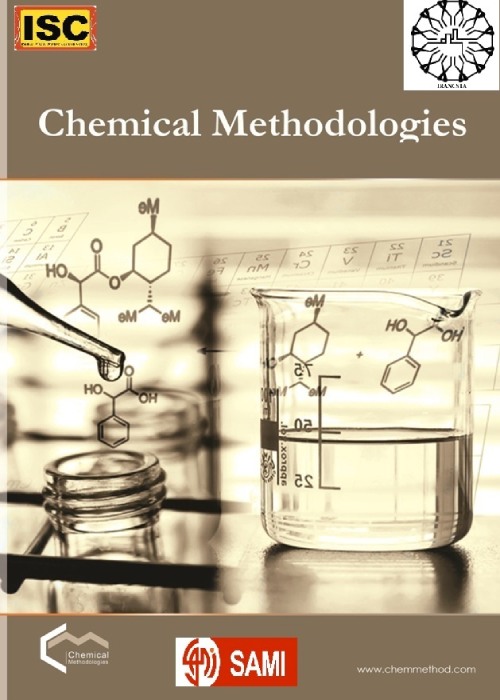فهرست مطالب
Chemical Methodologies
Volume:7 Issue: 8, Aug 2023
- تاریخ انتشار: 1402/07/04
- تعداد عناوین: 5
-
-
Pages 581-593In the lubricating oil industry, multifunction additives have garnered considerable interest because of their ability to significantly enhance and add different functions. This study details the two-step synthesis of pyranopyrimidine derivatives. The initial step entails a three-component, one-pot reaction of pyrrole-2-carboxaldehyde, malononitrile, and 3-methyl-1-phenyl-2-pyrazoline-5-one, or dimedone, or barbituric acid, to produce compounds (1-3) using nanoparticles magnesium oxide (MgO-Nps) as the catalyst. In the second step, these products are cyclized with isothiocyanatobenzene to form the desired pyranopyrimidine derivatives (4, 5, and 6). The structures of synthesized compounds were confirmed using FTIR and 1H-NMR spectroscopies. The pyranopyrimidine derivatives were blended with the base lubricating oil, and then evaluated as effective antioxidants, corrosion inhibitors, and anti-rust agents using the IP-280 test (Institute of Petroleum's testing method), ASTM-D-130 and ASTM-D-665 tests (American Society of Testing and Materials methods), respectively. Furthermore, pyranopyrimidine derivatives were investigated for antimicrobially induced corrosion (MIC) by molecular docking on the rubredoxin (2DSX) protein from Desulfovibrio gigas bacteria and the cytochrome-c3 (2CTH) protein from Desulfovibrio vulgaris bacteriaKeywords: pyranopyrimidine, Nps MgO, Lubricating oil, Multifunction additives, Molecular docking, MIC
-
Pages 594-604In this study, binuclear complexes with the general formula [M2LCl4] were prepared, which were derived from salsaldehyde with 3,3′-Dimethyl-[1,1′-biphenyl]-4,4′-diamine (toluidine) and metal ions M= Co (II), Cu (II), Cd (II), and Pt (II) in a ratio (2:1) (metal: ligand). These complexes were characterized by elemental analysis (CHN), UV-Visible, FT-IR, 1H-NMR, and magnetic susceptibility, scanning electron microscopy (SEM), and molar conductivity. All complexes are non-electrolytic as the measurements confirmed that the complexes have a square planar structure. SEM showed that the complexes were of nanometric structure. The biological activity of the prepared complexes was tested to inhibit the growth of three types of bacteria: Escherichia coli, Pseudomonas aeruginosa, and Staphylococcus aureus.Keywords: Schiff bases, Metal complexes, Biological activity, sem study
-
Pages 605-612In the present study, the bio sorbent was investigated for its surface functional groups using Fourier transform infrared spectroscopy (FTIR), Scanning electron microscopy (SEM), and X-ray diffraction (XRD). Before and after bio sorption studies, The FTIR spectra for the study's bio sorbent were acquired, and it was discovered that the sites on the bio sorbent that accommodate the exchangeable dye could function as active sites for the exchange of dye. The significant numbers of heterogeneous pore layers in the bio sorbent that are clearly visible in the SEM microscopic image indicate that there is a good chance for the adsorption of the dye. However, the surface of the dye-loaded bio sorbent demonstrates unmistakably that the bio sorbent's surface was covered in dye. The XRD analyses verified the bio sorbent's amorphous and crystalline character.Keywords: Congo red, Spathodea campanulata leaves, Textile wastewater, FTIR, SEM, XRD
-
Pages 613-636So far, many efforts have been made to obtain suitable drugs and vaccines against the new coronavirus. Virtual screening methods are very efficient due to their low cost and high performance, and they are also widely used for designing new herbal medicines. Datura and Hyoscyamus, from the Solanaceae family, have many medicinal properties. This research identified potential compounds from the plants Hyoscyamus niger and Datura stramonium using molecular docking and dynamics studies. These plants have alkaloids, glycosides, terpenoids, steroids, flavonoids, tannins, and saponins. Many of them have attracted significant interest due to their variety of pharmacological activities and may have the potential to cure the new Coronavirus. Therefore, 93 known compounds were investigated, and then five compounds with the lowest binding energies were chosen for docking study. Additionally, atomic molecular dynamics simulation was performed to discover the dynamic behaviour of the main protease (Mpro): ligand complexes. Fraxtin indicated potential activity to inhibit the main protease (Mpro), but further in vitro, in vivo, and clinical trial studies are needed to confirm this claim.Keywords: Coronavirus, Hyoscyamus niger, Datura stramonium, Molecular docking, Molecular dynamics simulations
-
Pages 637-649This work presented synthesis for Schiff base 5-(anthracen-9(10H)-ylideneamino)-2-phenyl-2,4-dihydro-3H-pyrazol-3-one (L3), this ligand was synthesis from reaction for one equivalence of (Anthrone) with one equivalence for 3-Amino-1-phenyl-2-pyrazoline-5-one and its complexes for metal ions (Mn (II), Co (II), Ni (II), Cu (II), Zn (II), Cd (II), and Hg (II)). The Schiff base and its complexes were characterized by C.H.N, FT-IR, UV-Vis, (1H,13C-NMR and Mass spectroscopy only ligand) along with (atomic absorption spectrophotometer, chloride contents, conductivity measurement, magnetic susceptibility, and thermal gravimetric analysis only complexes). Along with to evaluated their biological activity against the types from bacteria and melting point. Based on data of all techniques suggested an octahedral geometry of complexes except complexes Cd (II) and Hg (II), it showed the shape tetrahedral. The results showed biological activity against the kinds from bacteria for synthesized ligand and its complexes.Keywords: 3-Amino-1-phenyl-2-pyrazoline-5-one, Anthrone, Metal complexes, Biological activity


